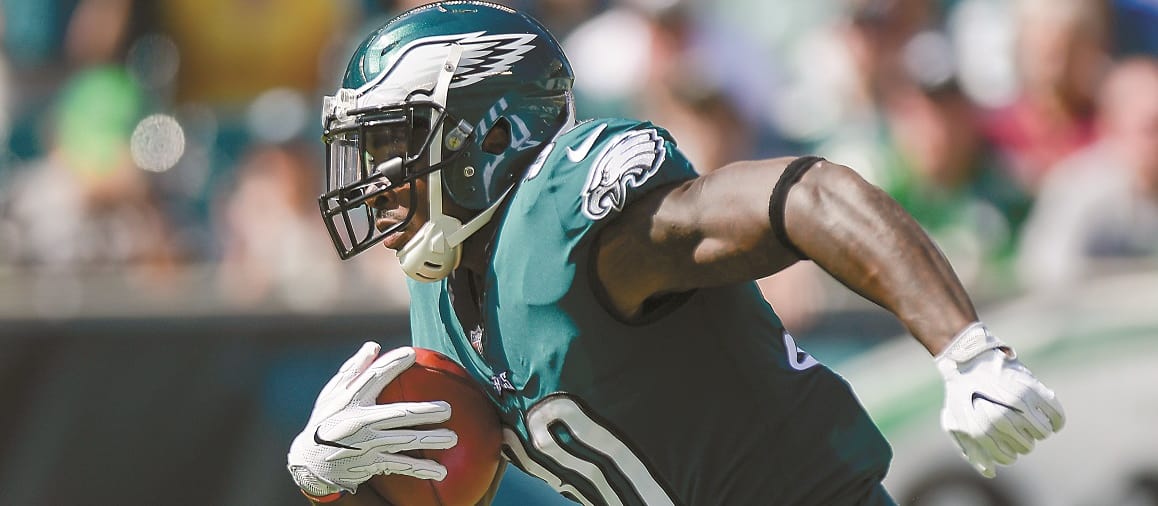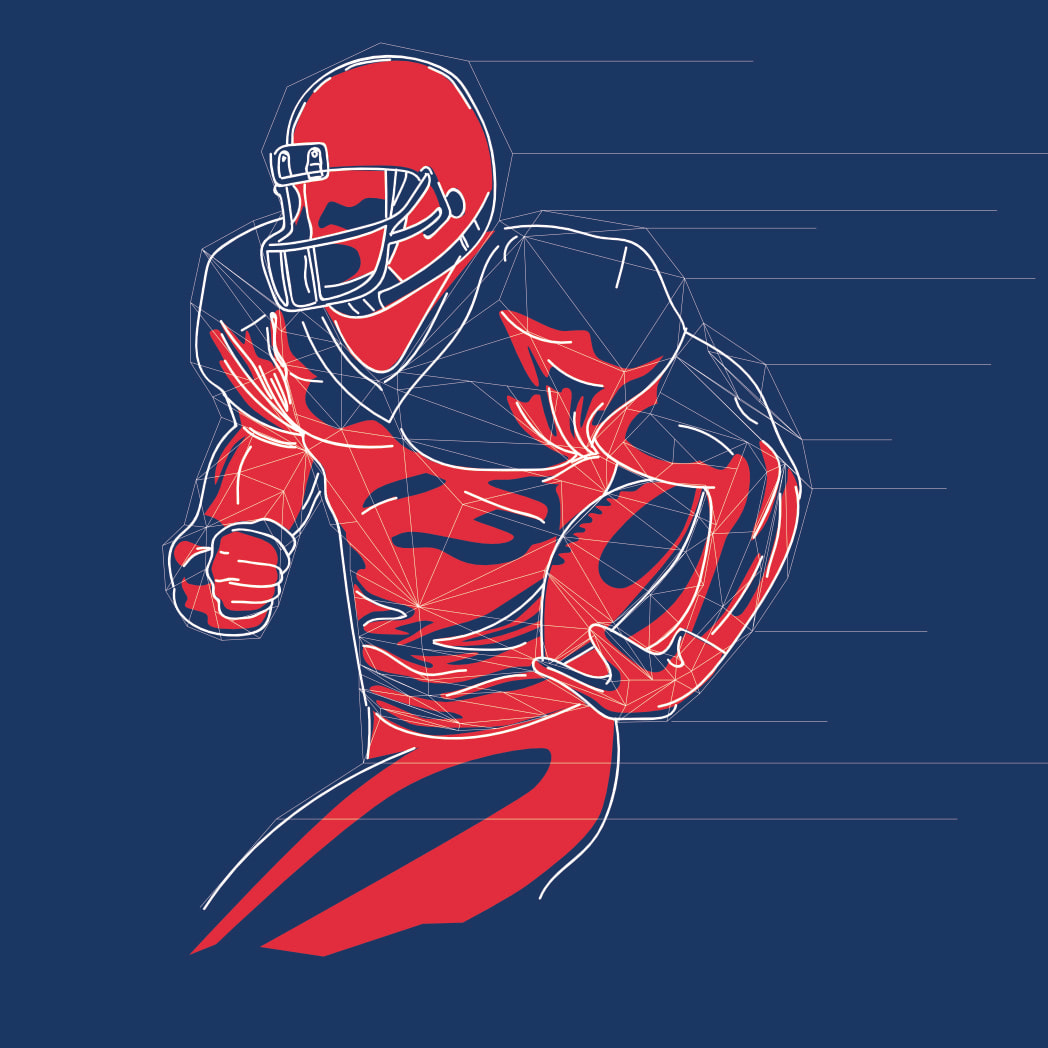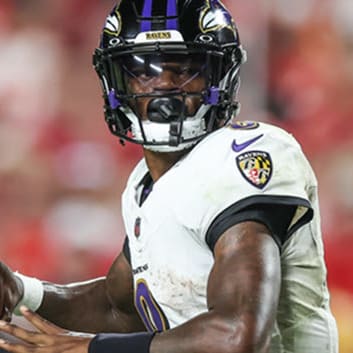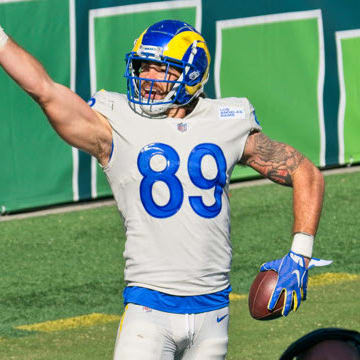This article is part of our Dynasty Strategy series.
We're going to expand our dynasty football coverage at RotoWire, and the first phase will be the installment of this column, which for the foreseeable future will run once a week and examine various subjects worth consideration to those playing in dynasty formats. We eventually plan to get around to expanding the dynasty content into an entire football subsection, so you can otherwise look forward to that.
Since most leagues have already had their rookie drafts for the 2018 season, this article will look at some long shot players, potentially unclaimed in mainstream leagues, who are worth monitoring as breakout candidates in the indefinite future. To make this exercise a challenge, I will only discuss rookies who went undrafted in May. There were seven I considered worth talking about.
TO BE CLEAR: you should expect nothing of these guys, especially in 2018. But if injuries or circumstances otherwise should push any of these guys toward opportunity, I think they have the skills or/and physical tools to take advantage.
In alphabetical order rather than descending value...
Josh Adams, RB, Philadelphia
Corey Clement went undrafted last year yet emerged as a leading contributor on Philadelphia's scorching offense in the second half of last year, so Adams' undrafted status alone isn't a good reason to write him off. That's especially true because he's probably more talented than Clement.
The question of whether Adams can make the final Philadelphia roster and earn a role is not necessarily pending the determination of who is 'better' between him and Clement, however. Indeed, Clement should be considered the favorite because even if he's less talented than Adams, his year of familiarity with the Doug Pederson system and the goodwill he rightfully earned with his play last year gives him a tangible head start over Adams. If Clement pulls a hammy in training camp and Adams gets two weeks of escalated reps, though, that advantage might dissolve.
Adams becomes very intriguing in that scenario, especially in the long run. Jay Ajay is in a contract year and has long believed to have a problematic knee, and Clement doesn't project as a long-term starter for the most part. Adams doesn't project as a traditional starter, either, but the athleticism and especially the skill set imply a player capable of providing fantasy value if he sees a significant role.
Adams was highly explosive at Notre Dame, where he ran for 3,201 yards (6.7 YPC) and 20 touchdowns in 37 games, adding 41 receptions for 336 yards and two touchdowns. He would ideally add at least 10 pounds to his frame because he's currently thin at 6-foot-2, 213 pounds, but in the meantime he has encouraging speed and quickness with a 4.51-second 40-yard dash and 6.78-second three-cone drills. NFL.com even cited a top game speed of 22.37 miles per hour for Adams in one game last year, which would generally compare more to 4.4 speed.
Mike Boone, RB, Minnesota
Roc Thomas is probably the most heralded of the undrafted rookie running backs on the Vikings, largely due to his superior recruiting pedigree – he was at Auburn before he was at Jacksonville State – but I suspect Boone, from Cincinnati, is the better prospect.
Neither player is likely to emerge as more than a rotational runner given their light builds, with both Thomas (5-foot-10, 198 pounds) and Boone (5-foot-10, 206 pounds) more so resembling third-down backs, but both show some promise as off-the-bench runners. Although Thomas is likely the favorite given his recruiting pedigree and the fact that he was invited to the NFL Combine while Boone was not, Boone tested substantially better as an athlete, and I'd argue that his college production, while disappointing, was more convincing than Thomas' was.
Boone was dynamite his first two years at Cincinnati, torching Bearcats opponents for 1,399 yards (6.8 YPC) and 18 touchdowns in his first 20 games. Unfortunately, his production fell off a cliff in his final two seasons, totaling just 851 yards (4.0 YPC) and six touchdowns in 19 games while struggling to stay healthy. Foot and ankle troubles plagued him consistently over that stretch. You can't just wave away durability concerns, especially when complemented by inadequate production, but Boone's trajectory reminds me somewhat of Elijah McGuire's. McGuire was off to a blazing fast start at Louisiana-Lafayette before chronic foot issues weighed him down, but he had better luck with the Jets last year. Given how great his first two seasons were, I'm inclined to chalk up Boone's substandard production the last two years to injury.
Aside from his promising early-career production, Boone's strongest selling point is his athletic testing. He lit up Cincinnati's pro day with a 4.44 40-yard dash, 42-inch vertical, 139-inch broad jump, and 6.95-second three-cone, and that broad jump especially is a remarkable figure.
Dalvin Cook has a long history of injury troubles and Latavius Murray isn't known for his durability, either, so keep an eye on both Boone and Thomas this preseason to see if one claims that RB3 role in Minnesota.
Steve Ishmael, WR, Indianapolis
Ishmael wasn't invited to the combine but there are plenty of indicators of NFL viability in his prospect profile. If it goes right for him, he might resemble someone like Stevie Johnson.
At 6-foot-2, 212 pounds, Ishael has the size and body control to play outside, but lacks the speed to easily project at that spot with a 4.59 40 from the Syracuse pro day. He might need to make it primarily as a slot receiver, then, but he has the hands and quickness (6.84-second three cone) to project well there. Ishmael's production otherwise checks two important boxes: early breakout age, leading Syracuse in receptions, receiving yardage, and receiving touchdowns at age 20 in 2015, and then one high-volume season as a senior by catching 105 passes for 1,347 yards and seven touchdowns in 12 games (60.3 percent catch rate, 7.7 YPT).
Expect Ishmael to begin the year on the practice squad if Ryan Grant and Chester Rogers are both healthy. Like Ishmael, they both project more easily in the slot than outside, and as veterans who cost more they'll both get shots before Ishmael.
Ray Lawry, RB, Cincinnati
I'll go ahead and say that Lawry is better than Mark Walton, Cincinnati's fourth-round pick out of Miami. Lawry is unlikely to make the team at Walton's expense – though let's not rule it out after Matt Breida beat out fourth-round pick Joe Williams last year – so he's likely to begin the year on the practice squad, but this guy can play. If Joe Mixon or Gio Bernard should get injured, Lawry would be a candidate for promotion at that point, and Walton probably isn't good enough to hold him off in a fair race.
Lawry can really play. He finished his Old Dominion career with 4,080 yards (6.2 YPC) and 45 touchdowns in 43 games, adding 60 receptions for 496 yards and three touchdowns. One subtle detail that encourages me is the fact that Lawry had another good running back on his team in Jeremy Cox, yet Lawry easily outplayed him, as Cox's rushing average over the last three years sits at 4.9, a sharp contrast to Lawry's 6.2.
Lawry runs even lower than the 5-foot-9, he's listed at, giving him good density despite the relatively light 205 pounds he weighed at the Old Dominion pro day. He showed poor agility numbers there (11.5 agility score), but his tape immediately shows an abundance of quickness, making it easy to blame his poor numbers on the bad weather he was running in that day. His 4.51-second 40-yard dash from the pro day is otherwise encouraging. Lawry dealt with a lot of hamstring troubles at Old Dominion and therefore probably doesn't profile as more than a change-of-pace back, but he reminds me of Ahmad Bradshaw a bit.
Ryan Nall, RB/TE, Chicago
Nall might not have a position now, but guys as productive as him with his athletic profile usually develop at the pro level with time, and in Chicago he could have a profitable eventual role either as a runner or tight end. His background is actually quite similar to that of Trey Burton, who's expected to produce as a tight end this year for the Bears.
Like Burton, Nall faces a potential move to tight end due to his build, but he's always been a runner by trade. Burton played a sort of QB/RB/WR hybrid at Florida, while Nall was a workhorse running back at Oregon State, totaling 2,216 yards (5.8 YPC) and 24 touchdowns over the last 30 games, adding 56 receptions for 563 yards and four touchdowns.
Nall's athleticism is vaguely promising, especially by tight end standards, as he stands at 6-foot-2, 232 pounds with a 4.58-second 40 and 11.11 agility score. Check out how those numbers compare to other tight ends. You'll notice Jordan Reed and Burton among the comparable players.
Terry Swanson, RB, Houston
Lamar Miller has been injury prone for years, and D'Onta Foreman is making a return from a late-season Achilles' tendon tear. We should be curious about who wins the RB3 role in Houston. Swanson is a fine candidate.
At 5-foot-10, 208 pounds, Swanson was highly productive for Toledo the past four years, turning 614 carries into 3,601 yards (5.9 YPC) and 31 touchdowns in 49 games, adding 55 receptions for 492 yards and two touchdowns. Tyler Ervin is a former fourth-round pick, but one who's done nothing to this point, and incumbent third runner Alfred Blue has a career rushing average of just 3.6 yards per carry on 523 attempts.
Particularly if Swanson can match Blue's special teams contributions at a lower salary cap hit, Swanson could give the team a more explosive option in that role. He ran a 4.51-second 40-yard dash at the Toledo pro day.
Akrum Wadley, RB, Tennessee
Wadley went undrafted out of Iowa because his size-adjusted athleticism is rather lacking, but he might have the skill set to overcome that fact anyway, and in Tennessee he has a realistic shot at earning the RB3 role behind Derrick Henry and Dion Lewis. It's particularly encouraging for Wadley's chances that his skill set is so similar to Lewis' – he should fit like a glove as a Lewis replacement if the veteran runner should need to miss time at any point.
Wadley is light at 5-foot-10, 194 pounds, but if his build doesn't hold him back then his 4.54-second 40-yard dash should prove sufficient given his advanced skill set. Lewis, one might recall, ran a 4.57 40-yard dash at 193 pounds, after all. Like Lewis, Wadley is a high-motor, shifty runner with an uncanny ability to elude tacklers, piling up results that conventional wisdom says shouldn't be possible for a runner with such modest athleticism.
Wadley finished his Iowa career with 2,872 yards (5.4 YPC) and 28 touchdowns in 39 games, adding 71 receptions for 761 yards and seven touchdowns. Those numbers invite even further comparison to Lewis, who finished his Pittsburgh career with 2,860 yards (5.3 YPC) and 30 touchdowns in 25 games, adding 52 receptions for 405 yards and a score. It appears Wadley's primary competition are veteran journeyman David Fluellen, and fellow undrafted rookie Dalyn Dawkins, who seems a significantly lesser prospect than Wadley.












